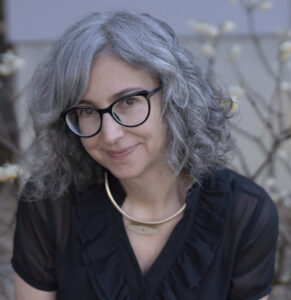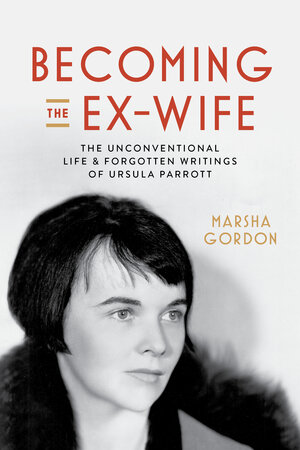
Credited with popularizing the label “ex-wife” in 1929, Ursula Parrott wrote provocatively about divorcées, career women, single mothers, work-life balance, and a host of new challenges facing modern women. Her best sellers, Hollywood film deals, marriages and divorces, and run-ins with the law made her a household name. Part biography, part cultural history, Becoming the Ex-Wife establishes Parrott’s rightful place in twentieth-century American culture, uncovering her neglected work and keen insights into American women’s lives during a period of immense social change. With elegant wit and a deft command of the archive, Marsha Gordon tells a timely story about the life of a woman on the front lines of a culture war that is still raging today.
Marsha Gordon is Professor of Film Studies at North Carolina State University, a former Fellow at the National Humanities Center, and the recipient of a National Endowment for the Humanities Public Scholar award. She is the author of numerous books and articles and codirector of several short documentaries.
What inspired you to write a biography about Ursula Parrott and what drew you to her work as a Hollywood screenwriter and author?
In 2015, I was tipped off to a collection of F. Scott Fitzgerald screenplays in the special collections archives at the University of South Carolina. When I made an appointment to look at the materials, I had a limited amount of time, so I picked the screenplay that had the best title— Infidelity! Fitzgerald had been hired by MGM to write this screenplay in 1938, and I will never forget what I wrote in my notes about the author of the story Fitzgerald was adapting: “Who is Ursula Parrott?” I had never heard of her!
The more I learned about her—from her 1929 best-selling book Ex-Wife, to her prolific publishing career and her movie work—the more interesting I found her and the more shocked I was that none of her books were in print. In fact, she had been totally erased from the story of 20th century American literature, film, and culture. I hope my book begins the work of telling her story and bringing renewed attention to her fascinating and immensely readable writings.
In what ways do you believe Parrott’s writing was prescient, anticipating issues that were not widely raised until decades after her decline into obscurity?
Parrott saw a lot of the impossible contradictions of modern life for women, especially involving relationships, sex, marriage, child rearing, and work. If you read her writing and ignore the period-specific elements—speakeasies, slang, fashion, and the like—it’s shocking how much of what she says would not be out of place in a modern novel or conversation. She called out a lot of male behavior that we are still reckoning with in the #MeToo era, even though she was engaging with these things in the 1920s and 1930s.
How did you go about researching Parrott’s life and work, and what were some of the challenges you faced during the process?
Writing a biography is a bit like being a detective. You follow trails and clues, hit a lot of dead ends, pick up threads, make inquiries, and just keep on digging as you pull together the best paper trail you can to tell a version of a person’s life. It’s a heavy responsibility, especially when you admire and are sympathetic to the person you are writing about. This gets especially challenging when it comes to someone who has left behind no archive. When Parrott died in the 1950s, she was down on her luck and there was not a single obituary published to commemorate her passing. Nobody tended to her legacy.
When I was a fellow at the National Humanities Center (2019-2020), I set about reading every novel, story, serial, and article Parrott ever published—which took me about a year. That gave me a fantastic sense of her interests and writing style. As I learned more about her personal life through her surviving correspondence with her literary agent and with one of her great loves— both of whom deposited their personal papers with archives — I also realized how much her fiction was about her own life experiences. I pieced together the puzzle of her life through her letters, the vast number of newspaper and magazine stories about her, and her body of published writings.
What do you think Parrott’s legacy is in American culture, particularly in terms of her contributions to women’s literature and feminist thought?
I think this remains to be seen, since influence can only be gauged by what people read, talk, and publish about in the present day. For so long Parrott has been sidelined, relegated beyond the margins of twentieth century literary and intellectual life. And she’s a complicated figure, too—she claimed to have disdain for feminism, but she usually behaved and wrote like an ardent feminist! If people—especially teachers and professors, book reviewers and journalists—discuss and share her work with a new generation, I’m confident that she will have a well-deserved place at the table.
Can you talk about Parrott’s writing style and how it evolved over the course of her career?
She had tremendous wit. Even in her darkest hours, she cracked jokes that would make me laugh out loud when I read them in her letters and stories. She had the capacity for the kind of zinger line that we associate with Dorothy Parker, whom I’m sure she associated with when she was hanging out at the Algonquin and the other smart New York places. I also believe that she’s one of the great forgotten writers of life in New York City, describing life there in prose perfectly suited to its rhythms, with details—musical notes, cocktail recipes, wisecracks, speakeasy descriptions—that masterfully evoke a time, place, and feeling.
How did Parrott navigate the challenges of being a female writer and Hollywood screenwriter during a time when women’s voices were often marginalized?
Despite her alleged distaste for feminism, Parrott did what she could to represent the unvarnished truth about many pressing issues confronting women. When she went to Hollywood, she did her best to make the female characters she wrote scenes and dialogue for both worldly and smart. These were women who could hold their own in any conversation or setting, from the barroom to the bedroom. She spoke openly with the press and in her stories about raising her son without his father’s help. In stories, interviews, and letters, she discussed how women had to learn to deflect men’s advances—in cab rides home, at parties, while conducting business. When a banker once suggested to her that she could pay interest on a loan with sexual favors, she deflected his suggestions and proudly announced that “I pay ‘em six percent interest, like all the men who borrow from them.” Parrott knew, in other words, that all women had to fight different battles than their male counterparts. It’s one of the things that made their lives so much more difficult, and their victories so much harder won.
What do you hope readers take away from your book, and what impact do you think Parrott’s story and writing can have on contemporary debates about gender and feminism?
First and foremost, I hope that reading my book makes people want to read Parrott’s books! Fortunately, McNally Editions is republishing Ex-Wife, Parrott’s 1929 debut bestseller, in May, so that’s the easiest way to get started with a really wonderful and interesting read. I hope that people will discuss what Ex-Wife had to say about women’s lives in the 1920s, and also what it might reveal about the present state of debates over gender roles and feminism.
Finally, can you tell us a bit about any upcoming projects or research that you’re currently working on?
I have a lot of different projects at their beginning phases, but there are two that directly grew out of writing this book. First, I’m trying to get a press interested in republishing Breadwinner, Parrott’s phenomenally interesting 1933 novella, serialized in Redbook. It’s about an ambitious and successful woman screenwriter who is also a single mother whose beau cannot accept how greatly her success outpaces his. I think that it might be the first women-centric work-life balance novel, as well, written at a time when the pull of career, family, and home were just emerging for women, who had never had so many opportunities and pressures before. I’d also love to edit a collection of Parrott’s short stories, selected letters, and articles—including her amazing 1929 manifesto, “Leftover Ladies.” I am really hoping that a press realizes how relevant her writing is, both for a general readership and for classes in American literature and women’s studies. Ursula Parrott richly deserves the attention!
